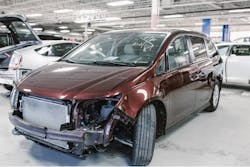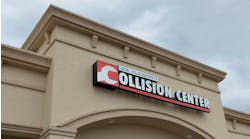In Aaron M. Sworden’s experience, body shop employees are constantly faced with a pressure-packed scenario: Both customers and dealership leaders, ideally, want cars to enter a facility on Monday and to depart by Friday.
That, of course, can create a tense work environment. Sworden sees it now, during his coaching and consulting work (he works with Impact AMS, Fixed Performance, and VeriFacts), and he especially noticed it while working as a damage analysis estimator/blueprinter at a high-production dealership body shop near Pittsburgh, from 2013–2015.
“So many things are out of a shop’s control when looking at a job …” he says. “It’s very difficult to control cycle time, or control length of rental, on a car that has back-ordered parts, or when waiting for third parties such as part and sublet vendors, or insurance partners. A shop’s length of rental is subject to the timeframe the third part operates under.”
Sworden learned long ago that entities like insurers and OEMs pay close attention to length of rental (LOR), and expect to see as low of a number as possible. LOR, which accounts for the day a rental vehicle ticket opens and the day it closes, is typically viewed as important because, theoretically, if a shop has a low LOR, it’s usually an indication of its solid processes. Most collision repair centers aim for an LOR that’s 2–4 days better than its market average, largely because such a tidy figure can help a facility acquire direct repair program business.
But, as Sworden learned a few years back, several elements of the collision repair world can make LOR a difficult statistic to track precisely.
The Backstory
Sworden boasts a well rounded resume. Before delving into the consulting realm, for instance, he spent a couple years as a general manager at a CARSTAR facility outside Pittsburgh. And, from 2013–2015, Sworden aided a four-brand dealership focused on high production and strict adherence to lean processes.
Sworden has taken lessons from each stop in his career, but especially from his experience at the dealership body shop. He learned, at times, that busy facility worked a bit too frantically for its own good.
A couple times per month, for example, LOR became skewed when a vehicle would arrive at the dealership body shop from a tow-in yard. LOR monitoring occasionally got lost in the shuffle when such third-party businesses were involved.
Sworden explains that, if a customer was in a rental car for a few days before his department had an opportunity to repair their vehicle, that tended to distort LOR. And that scenario presents a challenge for many shops.
“Shops need to focus on, and only be held responsible for, the portion of a length of rental that was equal to keys to keys at the shop,” he says.
The Process
Body shop employees are bound by the daily challenges they’re faced with, Sworden notes, such as being presented with a hectic, ceaseless workload on some days.
“Sometimes when you’re busy, things do take longer to fix,” he says.
A while back, he came to a conclusion: If a body shop loses sight of its repair plan or overlooks the blueprinting process, elements like LOR monitoring tend to suffer. And those oversights tend to lead to longer LOR.
In other words: In the collision repair business, it pays to establish relatively consistent repair plan procedures. Sworden knew that even before 2013, but that message was especially hammered home to him during his time at the dealership body shop.
“If, during the first 10 percent of a job,” Sworden says, “the repair facility does a proper disassembly of the vehicle, a proper damage analysis of the vehicle, and creates a proper blueprint or repair plan for the vehicle, the length of rental in those types of stores is significantly lower.
“The repair planning process today has evolved so much. … If you’re ordering parts on days 6, 7, or 8, you’re having a catastrophic effect on your statistics and your repair outcomes.”
By 2015, Sworden began coaching his co-workers to research their upcoming repair projects as promptly as possible, to give great consideration to ordering all necessary parts, and to schedule with load leveling as a prime focus. He adds that, in multiple management systems, collision repair employees can “flag” and input occasions in which a customer utilized a rental vehicle. Nowadays, he’s also a proponent of facilities having a body shop–specific management software program, in addition to estimating software and a dealership management system, so that a greater capacity exists for statistics, like LOR, to be tracked with ease.
The Results
By 2015, Sworden helped his old dealership employer near Pittsburgh grow significantly. He helped spur a dealership expansion, and he helped create a focus within the body shop on prompt blueprinting, overall repair planning, and adherence to standard operating procedures (SOPs). In doing so, he helped reduce LOR to 12 days.
These days, Sworden is passing on the lessons he has learned to an even wider audience, as a coach and consultant. He tutors repair facilities on the measures it takes to efficiently monitor measurements like LOR, ensuring that dealerships can keep that figure low enough to please insurance partners and OEMs.
“In the store, what I like to look at is the difference between the length of rental and the repair-order cycle time,” Sworden explains. “If that difference has some type of variance associated with it that is more than a day or two, that leads to asking questions about ‘Why?’ Why does your repair order start on Tuesday morning and the customer went in the rental car the previous Thursday? ...
“There are many operational questions that a shop has got to ask itself. A lot of times, a small amount of outside help can lead a shop to areas of opportunity that can reduce length of rental, and, ultimately, provide a better service.”



